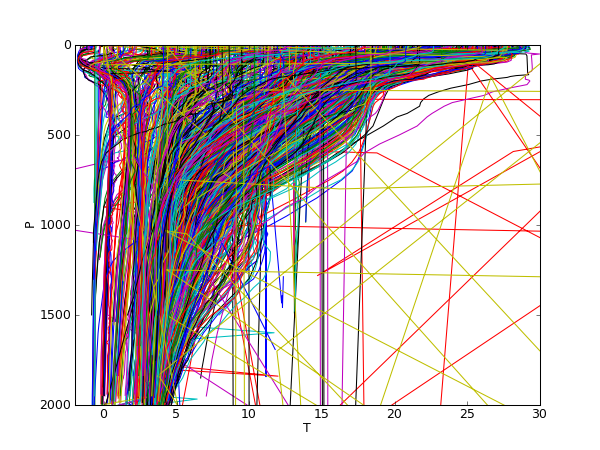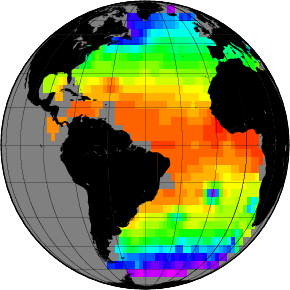Contents
2-dimensional interpolation and gridding
2-dimensional interpolation and gridding is a common problem for the representation of measurements on a map. Usually measurements are taken at irregular sample points and not in a regular grid. There are various approaches for the problem and the best solution depends on the data.
In the following we will look at oceanographic parameters that have been measured with the Argo system.
Example data from Argo system
Data are provided at, i.e. ftp://ftp.ifremer.fr//ifremer/argo/
First we have to download the data. Here is a /download script that can be used to retrieve one month of Argo data.
We extract only the surface temperature to reduce the large amount of data. This /extract script generates an overview of the data and writes the surface temperature in a file lat_lon_T.tab which contains latitude, longitude and surface temperature. We can use this file in the following.

Argo positions of measurements

Measured temperature profiles (unfiltered data).
Tools for 2-dimensional interpolation and gridding
Python
Help on function griddata in module matplotlib.mlab:
griddata(x, y, z, xi, yi)
``zi = griddata(x,y,z,xi,yi)`` fits a surface of the form *z* =
*f*(*x*, *y*) to the data in the (usually) nonuniformly spaced
vectors (*x*, *y*, *z*). :func:`griddata` interpolates this
surface at the points specified by (*xi*, *yi*) to produce
*zi*. *xi* and *yi* must describe a regular grid, can be either 1D
or 2D, but must be monotonically increasing.
A masked array is returned if any grid points are outside convex
hull defined by input data (no extrapolation is done).
Uses natural neighbor interpolation based on Delaunay
triangulation...
GMT
Nearest neighbor gridding with 5 degree grid cell size
nearneighbor lat_lon_T.tab -Rd -I300m -S300m -N1 -Ggrid.nc
Generate color table:
makecpt -Crainbow -T-2/30/1 > g.cpt
Plot grid files in 2-D
grdimage grid.nc -Rd -JG-45/0/4i -Cg.cpt -K > out.ps
Plot continents on map
pscoast -Rd -JG-45/0/4i -B15g15 -Dc -Gblack -O >> out.ps
Common options:
-G name of output grid. -R specifies the min/max coordinates of data region in user units. -J Selects map projection. -K Means allow for more plot code to be appended later. -O means Overlay plot mode.
Show resulting postscript map
gv out.ps
Convert to png format for this Wiki page
convert -trim out.ps out.png
Convert postscript to pdf format (you can zoom in the map with acroread)
ps2pdf out.ps acroread out.pdf

Exercises
Read the GMT manual:
- Find out the meaning of the options I, S, N of the nearest neighbor gridding
- What does -Rd mean?
- What does -Dc mean?
- What projection was chosen?
Produce new plots:
- Select a sub region of the data, i.e. only the North Atlantic.
- Select a different projection
- Plot the data with this projection
Use new interpolation parameters:
- Modify grid cell size (increment) to obtain a finer grid
- Modify search radius
Interaction with Python:
Read the GMT-netcdf file into Python with scipy.io.netcdf_file, (variable z)
Write a Python script that does the interpolation with GMT by using os.system()
Use different interpolation technique:
surface, adjustable tension continuous curvature surface gridding algorithm
